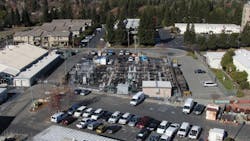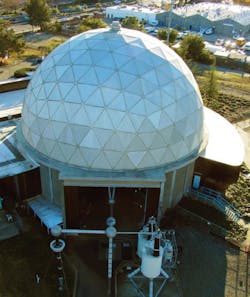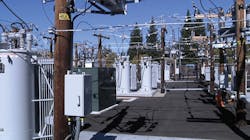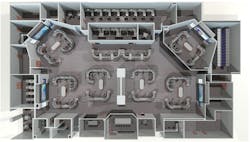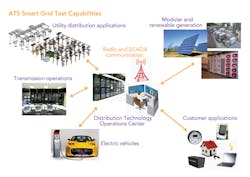Built in the early 1970s, Pacific Gas and Electric Co.’s (PG&E’s) San Ramon Technical Center is dedicated to conducting cutting-edge smart grid research. The work being done there, along with the utility’s experience as an early adopter of the smart grid, has provided the utility’s customers with enhanced safety and reliability, more insight into energy use and improved customer service.
The San Ramon, California, U.S., facility serves as home to more than 120 engineers, scientists and technicians committed to providing value for the utility’s customers. They provide engineering and testing services for the utility’s power generation, electric operations, gas operations and customer care lines of business, and serve as PG&E’s one-stop engineering services shop for the more than 2,500 incident investigations, dam inspections, failure analyses and nondestructive equipment examinations that occur every year at PG&E.
The facility’s high-voltage dome, perhaps its most recognizable landmark, is used to simulate events and aid in incident investigations. It has the ability to generate up to 720,000 V with full fog chamber capability. Featured on “MythBusters,” a Discovery Channel TV show, the facility also has its own substation that feeds a high current testing laboratory that can generate up to 80,000 A of fault current. A chemistry lab, materials science lab, instrument calibration facility and several strengths labs are also on site to test, pull or break every type of wire, pipe or pole imaginable.
Smart Grid Labs
As part of PG&E’s ongoing implementation of the smart grid, the newest — and most exciting — labs at the facility are dedicated to performing end-to-end testing of smart grid technology before it is launched in the field. To ensure value for the utility’s customers and a smooth technological rollout of any component, all equipment and control systems are rigorously tested before being piloted and deployed onto the grid to determine if they perform as advertised. The facility also provides technical feedback to manufacturers to help them refine their products to ensure plug-and-play value for the marketplace. These test labs have proven invaluable to the utility in evaluating components and determining deployment strategies.
Having a series of labs with interconnected capabilities gives PG&E a unique and exciting platform for smart grid testing. The utility has the capability to create a test, or simulation, system from beyond the customer meter to a secondary system, and up to the impacts on the distribution system. The utility also has the ability to replicate and simulate the smart meter system, supervisory control and data acquisition (SCADA) system and communication system.
Distribution Test Yard
In late 2012, PG&E completed construction of its distribution test yard. This lab — the San Ramon facility’s largest — boasts a three-circuit, three-phase simulation test facility that can be energized at 480 V or 21 kV. The test yard was outfitted with an operable supervisory control and data acquisition (SCADA) control and communications system, as well as PG&E’s SmartMeter network with additional integrations planned for the future. This distribution yard is primarily used to conduct operational testing as well as simulations for equipment and operating systems.
The test yard’s first major operational success was the extensive analysis and deployment of a self-healing fault location, isolation and service restoration (FLISR) system. Testing this equipment involved a combination of external current/power supplies with a LabVIEW control system that simulated several real-world scenarios to ensure the FLISR systems met PG&E’s needs. The utility rigorously tested systems from a variety of different manufacturers throughout the project to confirm which system performed best for PG&E’s distribution grid.
The selected FLISR system has already been deployed on more than 437 circuits throughout PG&E’s service area of central and northern California, which has resulted, so far, in fewer customer outage minutes and fewer sustained customer interruptions.
Modular Generation
PG&E is currently involved in a partnership project for anti-islanding testing using a real-time digital simulator to model distribution loading profiles. A modular generation test facility, originally constructed to test distributed generation technologies, also has the ability to test batteries of varying technologies, fuel cells, engine gen sets and flywheel storage, along with numerous residential and commercial range inverters simultaneously.
This lab also supports PG&E and its customers by evaluating emerging electric fleet technology and testing electric vehicle charging technologies. Recently, the facility successfully built and tested the U.S.’s first electric vehicle fast charger by conducting vehicle grid tests and demonstrations.
Next door to this facility, the lab also houses a distribution generation test yard where a number of large industrial-sized inverters, ranging from 500 kW up to 1 MW, can be tested using a 2,500-kVA distribution transformer connected directly to the grid to provide the power source.
Distribution Technology Operations Center
PG&E’s distribution technology operations center (DTOC) is focused primarily on identifying and testing promising technologies for potential integration into the utility’s distribution operations, especially its new distribution control centers. PG&E is in the process of integrating its existing 13 local distribution control centers into three regional, state-of-the-art centers.
The new centers will enhance electric reliability for the utility’s customers while providing system operators with the capability to shift workload between the facilities, if additional support is needed, such as during a storm or a natural disaster. To ensure a smooth rollout of the technology used in PG&E’s new control centers, the DTOC has been outfitted with many of the capabilities of a real control center.
The DTOC setup includes two prototype operator consoles, PG&E’s recently upgraded distribution management system (DMS), SCADA interface and controls, geospatial information system (GIS) tools and dispatch capability, and it interfaces with the utility’s SmartMeter advanced metering infrastructure system. Access to the full suite of operator technology tools enables end-to-end testing and demonstration of new technologies in a realistic operational test environment.
The DTOC is operationally tied to the distribution test yard and planned for integration with other smart grid labs at the San Ramon facility in the future. The DTOC also has facilitated valuable learning and training opportunities for both the utility and its system operators. The operators can learn the new technology they will be using in the new control centers in a risk-free environment, and then suggest changes to make the software and systems more effective.
The DTOC also has started to test next-generation smart grid technologies. PG&E recently launched three distribution-focused smart grid pilot projects — volt/volt-ampere-reactive optimization (VVO) , line sensors, and fault detection and location — all of which will be incorporated into the DTOC for testing. Integrating testing into the DTOC enables PG&E to test these smart grid technologies end to end before rolling them out systemwide.
Smart Grid Communications
Another aspect critical to ensuring the value of smart grid components for the utility’s customers is the facility’s smart grid communications lab. This lab is home to a radio-frequency test lab designed to test critical SmartMeter communications components, including the network that interfaces with the utility and the network that can interact with the home area network (HAN) devices in customers’ homes and businesses. The communications lab supports testing a number of future services, such as providing enhanced information to support grid operations, providing customers with information about their solar rooftop systems and enabling demand management options through HAN devices.
Synchrophasor Proof of Concept
Last, but certainly not least, is the utility’s synchrophasor proof-of-concept (POC) lab. This lab was constructed to support the Western Interconnection synchrophasor program (WISP), funded by the Department of Energy’s American Recovery and Reinvestment Act. The WISP involves nine organizations and numerous other stakeholders across the western United States.
The POC center includes a control room that has been built with both simulation and real-world control capability to evaluate equipment and technologies in a controlled test environment. As part of the WISP, PG&E installed phasor measurement units (PMUs) in more than 20 of its key substations and used the POC lab as the control room for system design, testing and applications development.
Upcoming Projects
Recently, the utility received approval to move forward on a four-year smart grid pilot project and a number of new technology demonstration projects; it will be focused on deploying numerous projects after lab testing has been completed. Several of the proposed projects will be tested rigorously at the San Ramon Technical Center labs.
The largest of the newly approved projects is the VVO project. VVO involves improving customer energy efficiency, grid loss reduction and integration of distributed solar photovoltaic generation systems into the utility’s distribution system. PG&E has more connected photovoltaic systems than any utility in the U.S. The utility will be testing VVO systems from numerous vendors at its San Ramon facility to determine the system that best fits the needs of its grid.
As part of this work, the distribution test yard will be used to test field equipment and automation. The DTOC will test the integration and operation of the VVO application in PG&E’s DMS and control rooms. The project has the potential to provide significant value to PG&E’s customers, but it is critical to ensure the equipment performs as advertised and is interoperable with existing infrastructure before final systems are rolled out into the field, even for a pilot test.
The lab also will be performing extensive testing of distribution line sensors. Again, this will involve all the smart grid tests referred to previously, but it also will include the use of the lab’s high current testing capability. Both of these projects are in the planning and data-gathering stages.
At the end of the day, this facility has been instrumental in ensuring PG&E’s customers receive the safest, most reliable and affordable service possible.
David A. Bradley ([email protected]) is the manager of technology application for Pacific Gas and Electric Co.’s applied technology services section. He is responsible for electrical testing, incident analysis and technology performance testing associated with PG&E’s utility system. He has more than 33 years of experience as a distribution and transmission engineer, supervisor and manager. Bradley holds a BSEE degree from the South Dakota School of Mines and Technology in Rapid City, South Dakota, U.S., and is a registered professional engineer in the state of California.
Ryan Hanley ([email protected]) is the manager of smart grid technology and integration for Pacific Gas and Electric Co.’s electric distribution operations organization. He is responsible for assessing, testing and rolling out promising distribution operations technologies for integration into PG&E’s operations, as well as managing PG&E’s distribution technology operations center. Hanley holds a BSCE degree from Johns Hopkins University, a master’s degree in structural engineering from Trinity College Dublin and a MBA degree from UC Berkeley.
Editor’s note: PG&E offers tours of the lab from time to time, so if you are a utility or a manufacturer that would like to visit the lab, contact David Bradley at [email protected] to arrange a tour.
Company mentioned:
Pacific Gas and Electric Co. | www.pge.com
